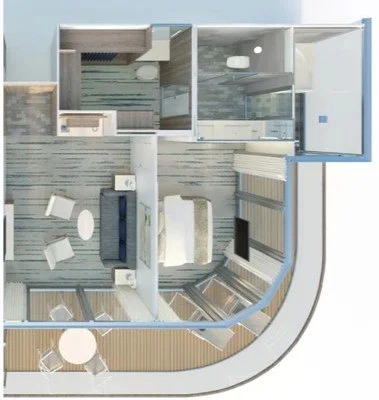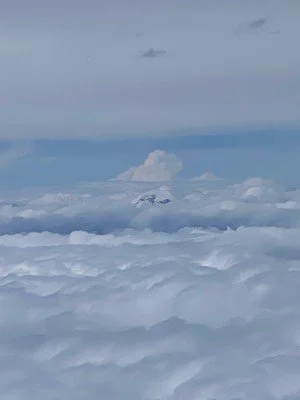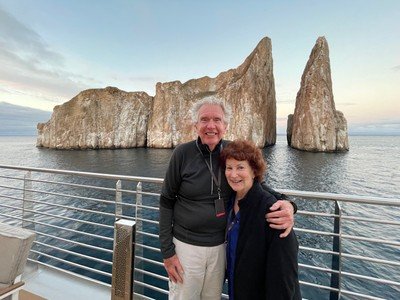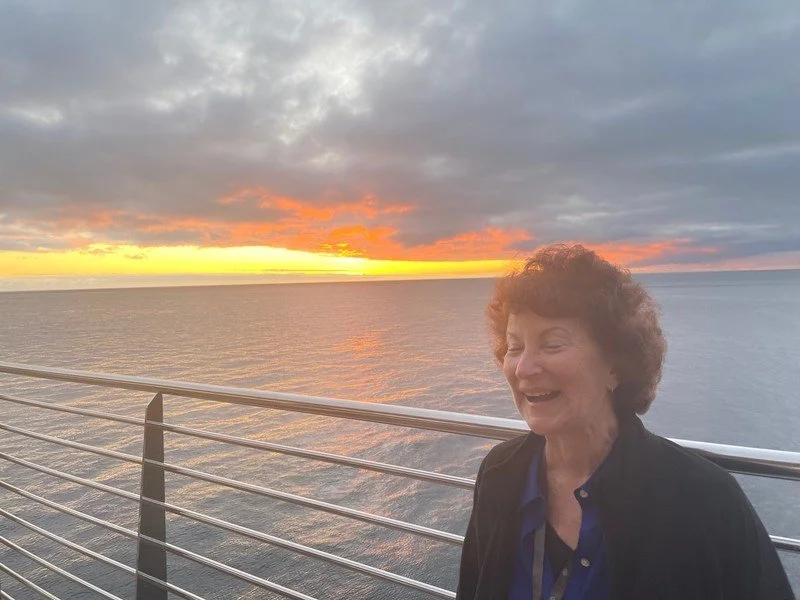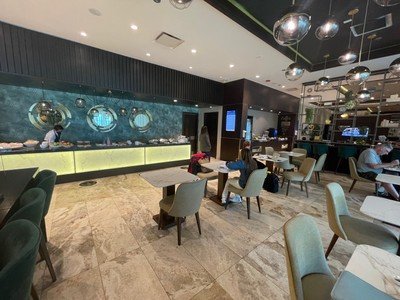3. Finally Here
Off we gos.
06.18.2022 - 06.18.2022 78 °F
Day 3, Saturday, June 18, 2022
At 6:50am, before they even start serving breakfast at the JW Marriott, we board our Silversea transfer vehicle to the Quito Mariscal airport. Seated in the coach, I am accosted by representatives of both Silversea and Marriott because "I have not checked out and owe them money." There are many facts in dispute here. First, I hold in my hand on my iPhone on my Marriott Bonvoy app proof that I have checked out. Second, the name they are chasing me for is either Peter Russell or Scott Russell. Third, there are two different room numbers on the charges that I have allegedly dodged, one the room we were in and another for a room we did not occupy. Fourth, when we checked in I presented my Marriott Credit Card which guaranteed all charges and from which they even put a $200 hold when I checked in so they were at risk for nothing. When I showed them my phone check out documentation, they gave up the dispute but did not apologize for embarrassing me with it. Humans take note: when you err, apologize and show empathy to those whom you have harmed. It costs nothing and goes far toward healing the wounds the error may have caused.
The fear that protestors would disrupt our safe and expedient passage were unrealized so we arrive at Quito Mariscal Sucre Airport at 7:50, 2.5 hours before our flight. Checking in for our LATAM flight 1419 to San Cristobal Island on an Airbus 319 is a piece of cake as Silversea has pre-screened and pre-tagged our checked bags. The documents we were provided indicated strict weight limits for carry-on bags at 15 pounds. Mine, loaded with camera gear, computer, iPad, Kindle, chargers, etc., weighs significantly more. They never checked. Bullet dodged.
Regarding the old expression, "Better Safe Than Sorry," in this situation, we are both. But wait...
There is a Priority Pass Lounge! Like a port in a storm, an oasis in the desert or a Shake Shack in the airport, the Priority Pass Lounge is a delightful and welcome treat. Free with many credit cards, membership gets you inside where soft seats, food and beverage, upgraded WiFi and more await. I love Priority Pass as a travel benefit. Kansas City traveller take note: our new Kansas City airport has no plans for a Priority Pass Lounge--a monumental oversight in my opinion.
We are in economy (6A window and 6B middle) for this three-hour-twenty-four-minute flight which features a stop in Guayaquil. Clearly, our upgraded transportation doesn't work with LATAM. In their defense, the last time I can remember flying them was many years ago and my membership number has been, justifiably, retired.
(From the comments section, Sandy and Laramona take note): We escape the thin air of 9,350 foot high Quito which, thankfully was noticed but did not interfere. My only negative experience with altitude sickness was in 2016 in Cusco, Pero, which at 11,155 feet above sea level--a couple of thousand feet higher than here--knocked me on my rear for a day even though the Marriott Hotel I stayed in piped pure oxygen into my upgraded sleeping room there. Seeing Machu Picchu was worth a day's physical discomfort, clearly, but I am relieved that neither B4 nor I succumbed to the less thin air here. Should you have too much time on your hands, the blog of that Machu Picchu trip is available at https://Paul2MachuPicchu.travellerspoint.com
Opting for the window seat--B4 never looks out the window preferring to read or do email--I am disappointed that clouds obscure what I was certain would be a wonderful view. Halfway to Guayaquil, however, I received my window seat reward. Chimborazo Peak peeked. At 20,528 feet, it's apex is the farthest point on the earth's surface from the earth's center--due to being that high and that close to the equator. If it were not on the equator it wouldn't be able to claim that title but, no matter where it is, on this day it defeated the clouds, earning a view of a planeful of passing explorers headed for the Galapagos.
Approaches to the San Cristóbal Airport, no matter whether you land from north to south or south to north, are overwater. There is high ground to the northeast. It's a sleepy place to land and receives only a few flights daily. If we were of a mind to, we could walk to town center from here in less than 15 minutes. The most controversial thing about this strip is that in June 2019, the Ecuadorian government gave permission for the US military to use the airfield as a base. The locals were not happy; who can blame them?
This, our final destination, “Discovered” in 1535 (by Fray Tomas de Berlanga, the Bishop of Panama who was actually headed to Peru), the Galapagos Islands, first formally explored by the Spaniard Malspina, are a volcanic archipelago about 600 miles west of Ecuador’s coast. It was here in 1835 that 26-year-old Charles Darwin—aboard The Beagle—developed the foundation for his theories of evolution.
In 1978, UNESCO labeled this as a World Heritage Site and, in 1985, as a biosphere reserve and then upgraded in 2001 to include the surrounding marine reserve. There are 13 main islands, said to be home to 25,000 people in total, surrounded by 215 islets and rocks. We are atop the Nazca Plate, a moving tectonic plate traveling at 2.5 inches per year. Scientists say the first islands were formed five million years ago.
Upon landing at San Cristobal, a 215 square mile island settled in 1832 and where 6,000 people now live, we are shuttled to the harbor adjacent to a statue of Darwin for our transfer to the ‘almost brand new’ Silversea Silver Origin. Temperatures average 77 degrees and the land masses are like desert hosting 600 vascular plant species, thirty percent of them exclusively found only here. Scientists have identified 1,432 plant species in total here. San Cristobal is home to Frigatebirds, sea lions, giant tortoises, Blue and Red Footed Boobies, tropicbirds, marine iguanas, Swallow-Tailed Gulls and is patrolled by dolphins.
We are booked into Royal Suite 528, an R1 Royal Suite at the starboard side aft corner of this, the smallest ship in the Silversea fleet. Silver Origin measures a short 331 feet in length and 52 feet abeam. Built specifically for this region, she is one of only two ships sailing here with both dynamic positioning and advanced propulsion systems—meaning we never once have to drop anchor on the fragile seabed during our entire week aboard.
She’s new. Just over three months ago on March 7, Silver Origin was christened at a ceremony marking the first ship christening for the new President & CEO of Royal Caribbean Group, Jason Liberty. Royal Caribbean Group acquired Silversea Cruises in 2018. Silver Origin was originally floated on December 30, 2019 but got off to a very slow COVID-19 mandated start in life.
Our Suite has a big veranda, walk-in closet, ocean-view bathroom with both a whirlpool bath and a walk-in shower and, with the veranda, measures just under 900 square feet. There is a 65-inch flat screen and lots of USB ports and electric outlets. The regular classic veranda suites are 325 square feet while the Owner’s Suite is 1,722 square feet. Every suite has a butler who stocks the mini bar with whatever you want—alcoholic or non-alcoholic—in whatever quantity you like. For us, we ask for prosecco to be always on ice.
We get robes and slippers and even expedition gear consisting of a safety jacket, wetsuit, mask, fins and snorkel, waterproof backpack, raincoat and a reusable water bottle. Binoculars are on the table. Laundry is included; so is unlimited “premium” WiFi. are available for complimentary use.
Dress aboard is different from ‘regular’ SilverSea vessels. On this ‘expedition’ vessel, shipboard attire is casual—evening during evening times with only jeans and shorts not permitted in The Restaurant. No jackets, please.
Holding a maximum of 100 passengers in 51 suites (we are told there are only 78 passengers aboard) and 90 crew (ten of them expedition leaders), this all suite ship was built in Dutch Shipyard De Hoop as an expedition vessel and launched mid-COVID with her maiden voyage completed less than a year ago. Eight Zodiacs (more on those later) can be launches—two at a time—from the sea-level fold-out stern embarkation areas equipped with hydraulic doors, hatches and cranes. There is one Zodiac for every 12.5 passengers which means minimal delays. The Deck 3 embarkation area is reached via an area known as “Basecamp” where pre-excursions briefings are conducted on a large interactive digital wall. It is home to a gigantic curved full wall LED screen where guides can reinforce their briefings from the podium’s touch screen—something a seminar presenter like me would have love to had “back in the day.”
On Deck 4 is the Explorer Lounge for daily briefings and pre-dinner cocktails and hors d’oeuvres, a Deck 7 Observation Lounge/Library, and more with floor to ceiling windows everywhere. Aft of the Explorer Lounge is a stern area outfitted with sun beds, a jacuzzi and a fire pit. On Deck 8 it’s lights out at the stargazing area where you can see both the Southern Cross and the North Star from this equatorial location.
There is a fitness center on Deck 5 along with a beauty spa for manicures and pedicures, a massage suite and all that stuff that B adores.
The two dining venues are “The Restaurant” and “The Grill”—an open-air venue--each of which is large enough to accommodate all 100 guests at a single 7:30-9:00 sitting. That’s on top of 24-hour room service offering in-suite dining. From reading and research, it seems that lots of our predecessors opt for room service breakfasts making early expedition departures easier to manage.
Promotional material boasts “fine local dining, wines, Champagne, spirits, beers, coffee and tea and soft drinks.” Onboard gratuities are included in the ticket price. There is a reserve list of wines available at an upcharge and I am anxious to see what that entails.
A promotional video can be found here: https://www.youtube.com/watch?v=Bdt0KnrpuVs or https://www.tlnint.com/whats-it-like-aboard-silver-origin/
The ships engines engage as we waste no time in sailing a mere three miles so we can begin seeing the sights.
First is picturesque Kicker Rock which is not rock at all but compacted volcanic ash that rises 500 feet above sea level. Technically, it is what remains of a lava cone that split into two parts. It is what remains of a former “tuff coneless” whose Spanish name is “Leon Dormido” or Sleeping Lion. It is actually two rocks, a large one about 1,000 feet long by 330 feet wide and 500 feet high. Separated by a narrow 65 foot deep channel is a secon obelisk rock. Snorkelers in the calm water which surround it encounter sea turtles, marine iguanas, rays, Galapagos sharks, tropical fish and, sometimes, hammerhead sharks.
Ashore, blue-footed boobies, masked boobies and frigatebirds populate the cliffs and sea lions lounge on the shore.
One definition of “boobies” is “seabird” but the English name is said to be based on the Spanish slang term bobo which means “stupid.” That derogatory term may possibly come from the fact that these birds are so tame that they formed a habit of landing on board sailing ships where they were easily caught and eaten. Boobies in flight can be seen diving straight down into the sea to catch fish. Air sacs beneath the skin around their faces cushion the impact from those dives. There are lots of Blue-footed boobies about along with Masked boobies and Nazca boobies.
Frigatebirds were first named by French mariners as: bird La Fregate—with the frigate part referring to a fast warship. English seafarers tended to refer to them, for the same reason, as Man-of-War birds. They are big—about three feet in length—and sport a wingspan of up to eight feet. Males have a magnificent red “gular sac” below their beek which they fill with air to attract females. Both genders have long narrow wings and forked tails. They dive for fish near the water’s surface but carefully don’t make contact with it.
They also harass the boobies in flight who then regurgitate the fish they have eaten so the frigatebird can convert it as their own meal. The technical term for this type bird is, appropriately, “kleptoparasite.” They spend the vast majority of their time—both day and night—aloft, often riding thermals to an altitude of as much as 8,200 feet before descending. Eggs are laid and young are raised in shallow nests in both bushes and trees.
This third day of our journey was a momentous "first" day.
